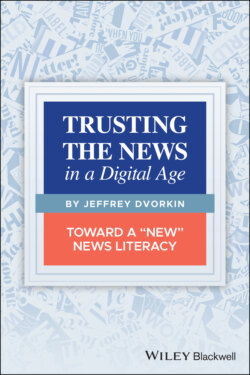Читать книгу Trusting the News in a Digital Age - Jeffrey Dvorkin - Страница 23
Watergate and the Role of the News
ОглавлениеThe economic basis of the news industry has always been part of the information‐driven culture. News organizations may believe that what they provide is a public good and an essential part of any democracy. But the need for news organizations to make a profit has always been a driving force in how the news is created and organized. Newspapers and broadcasters have relied on an advertising model to sustain them. Most news organizations in the US and Europe are supported by investors who purchase stock options. Shareholder satisfaction thus becomes an important element in how a news organization is run. Public broadcasters such as the British Broadcasting Corporation (BBC), the Canadian Broadcasting Corporation (CBC), and National Public Radio (NPR) rely in varying degrees on government funding or public subscriptions. Both public and commercial news organizations still rely heavily on substantial audiences. Tracking these audience numbers allows news organizations to charge proportional advertising rates. With public broadcasting, large audience numbers allow for continued subsidies from their respective governments. In short, competition for ratings is an essential part of the news landscape.
Getting the “big” stories into the news becomes an essential quality of this competitive aspect.
The high water mark of journalism, in North America, at least, may be the Watergate Scandal in the 1970s. Two young reporters from The Washington Post, Bob Woodward and Carl Bernstein, relentlessly pursued the story of a failed break‐in at the Democratic National Committee headquarters in the Watergate building in 1972, leading to the unveiling of a huge political scandal– they were given the freedom to chase the story to an extent that is unheard of today, when media organizations are facing tighter financial times.
As a result of their reporting (along with the reporting of other news organizations), the president of the United States, Richard Nixon, was forced to resign in disgrace.
Journalism and the news business were seen as patriotic and even saviors of the best values of civic engagement. Reporters and journalism were celebrated (for a few years anyway), and investigative reporting became a bigger part of many media organizations.
The news was also seen as a clear benefit to society, even as it became a recognizable profit center for news organizations. By the 1980s, and for the first time, the news by itself (without the financial support from other sections of the media organization, such as sports and entertainment) was able to bring new audiences and with it, more income to newspapers and broadcasters. Circulation and ratings soared. Newsrooms expanded as more journalists were hired. At the same time, universities created and expanded their academic journalism curricula.
Two factors would eventually change the once positive outlook on the news for the worse:
1 The arrival of 24‐hour cable news in the early 1990sAll news channels demanded increasing amounts of programming and content that could be buttressed by strong visuals – videos, photos, maps, graphs, typefaces and graphics, and anything else meant not only to supplement the material, but also to be eye‐catching. This allowed for the ingress of news consultants using audience analytics. Such consultants insisted that the “if‐it‐bleeds‐it‐leads” mentality should predominate.The rise of talk radio in the US also created an appetite and an audience for argumentative and opinion media. Fair‐minded, balanced news paled in comparison, and traditional news operations adapted and adopted a model that a few years before would have been rejected. Dramatic effect, especially in visuals, was seen as the basis for strong ratings, even if the story was inherently un‐dramatic.The definition of what constitutes “the news” changed. In the 1980s and 1990s, the news was seen as a formal, direct presentation of the day's more important events. But the Internet changed where people got their news and what the public perceived as “the news.” Increasingly, comedy, satire, and entertainment became acceptable sources of information to be consumed and shared. The so‐called “gatekeeper” role – or the role of filtering what information makes it to the public – of traditional news was changing, as the public used the Internet to bypass the old guardians of information. Emotional stimulation and entertainment became aspects of this changing news approach.
2 Digital technologiesBy the mid‐1990s, digital technology was introduced into news organizations. It gave more efficiency to the daily workflow, and at the same time allowed for a reduction in staff as computer technologies replaced the more traditional and labor‐intensive news operations. Digital technologies allowed for greater savings for media organizations. At the same time, the digital culture was shattering once reliable audiences that sought out their news from different sources.The early 2000s saw the traditional advertising model for newspapers collapsing. The rise of blogs, online media, and apps undercut the old business model for mainstream news organizations. Paying consumers were able to find the information they wanted elsewhere, and for free.The public's interest and even loyalty also began to shift as traditional media seemed unable to keep up with the proliferation of more exciting and nimble information forms. The arrival of alternatives such as Vox, Vice, and Buzzfeed were challenges and threats to the dominance of traditional media.Traditional media tried to adapt and recover their former audiences, not often successfully. Many news organizations attempted to appeal to a younger audience, especially on their websites. But the attempt to monetize their audiences by imposing paywalls (asking for a subscription fee to gain access) was not uniformly successful, and newspaper circulation and online subscriptions have continued to decline, with some exceptions.
